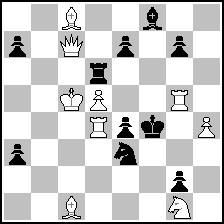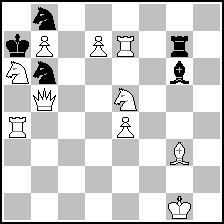
Website founded by
Milan Velimirović
in 2006
19:42 UTC


| |
MatPlus.Net  Forum Forum  General General  Are There Any? (Kriegspiel chess problems) Are There Any? (Kriegspiel chess problems) |
| |
|
|
|
|
You can only view this page!
| | | (1) Posted by Geoff Foster [Wednesday, Sep 23, 2009 06:03] | Are There Any? (Kriegspiel chess problems)
Many years ago I bought a copy of "Are There Any?", a book of Kriegspiel problems by G F Anderson, and it is one of my most treasured possessions. My copy has the following hand-written inscription: "To Norman J Whitaker, with whom I so often played chess - and lost, - with best wishes from, most cordially yours, Gerry Anderson April 3 1959". This book is much sought after, so I plan to quote parts of it on the forum. I'll start by quoting Anderson's description of the rules of Kriegspiel, then I'll quote one of the problems in a separate post. If this proves popular then I'll quote futher problems. Here are the rules, as given by Anderson:
Kriegspiel is played by two opponents neither of whom can see the other's board. A third person, who acts as the referee, keeps the true position on another board. All three sit side by side with the referee in the middle, and small screens prevent the players from seeing the other boards. The referee sees all of course.
The rules are very simple. A move that is legally possible in a game of chess must be played. If it is not possible the referee will say "No", and the player will then go on trying until he does make a legal move. The referee will then announce that White (or Black, as the case may be) has played.
The players endeavour to find out about their opponent's position by making trial moves, such as attempting to move a Rook all the way along the bottom rank. If a player cannot do this he concludes there is a piece in the way. Towards the end of a game a good player will have a fair idea of where many of his opponent's pieces are.
To assist the players in their deductions certain information is made available, as follows:
(1) A player may ask if he can capture anything with a pawn. He says "Are there any pawn captures?" or "Are there any?" or simply "Any?". If there are, the referee will say "You can try." The player must then make at least one attempt to capture. If he succeeds, the move stands. Otherwise he is free to make some other move, or he can go on trying to make the capture until he does succeed.
(2) The referee will announce checks, and the nature of the check. He will say "Check from a Knight", or "Check on the rank", or "Check on the file", as the case may be. If a diagonal check is given he will say whether it is on the long or the short diagonal passing through the checked King's square. This is announced as "Check on the longs", or "Check on the shorts". In the case of double checks he will announce both.
(3) The referee will also announce captures. He will say on which square the capture takes place, but will not disclose what piece has been captured or what piece has done the capturing. For example, if a player moved his Rook standing on a1 the whole length of the rank, and captured, the referee would say "Capture on h1".
| | | (2) Posted by Geoff Foster [Wednesday, Sep 23, 2009 06:37] |
Here is problem No. 29 from "Are There Any?" by G F Anderson.
 (= 9+10 ) (= 9+10 )
Kriegspiel #3
1.Rd1 (threat 2.Re1 any 3.Bxe3)
1...e5 2.Rf1+ gxf1 3.Rg4
1...e6 2.Rf1+ gxf1 3.Qf7
White's plan of campaign in No. 29 is tactically very simple. It entails bringing the Rd4 round to bear upon the pinned Black Knight, so that White may play 3.Bxe3 mate. There are several ways of carrying out this manoeuvre. For example, any move of the Rook to the left, followed by his stepping on to the third rank, would seem to do the trick, but all fail miserably in the face of Black's storming defence 1...e5 which unpins the Black Rook and threatens a murderous discovered check.
However, at e6 the pawn interferes with the Black Rook, and at e5 it self blocks, and White would quickly turn these weaknesses to good account if only he could separate them. This is how he does it. He plays 1.Rd1, then after Black plays, White asks "Are there any?". If the answer is "No", he can safely play 2.Re1 and 3.Bxe3 mate. A "Yes" answer would indicate that the pawn has moved, though White does not, at present, know to which square. After rejecting the pawn capture by attempting to play 2.d5xc6, White's next step is to sacrifice the Rook on f1, for the odd reason that he must deprive himself of the right to capture en passant. This explosive sacrifice isolates the Black Pawn's moves, for when White does the asking process all over again he now gets a "Yes" if the pawn is at e6, and a "No" if it is at e5. He then mates accordingly with 3.Qf7 or 3.Rg4.
| | | (3) Posted by Michael McDowell [Wednesday, Sep 23, 2009 07:10] |
This and other problems from "Are there any?" are discussed in an article in The Problemist July 2006, which can be viewed on the BCPS website.
| | | (4) Posted by Jacques Rotenberg [Wednesday, Sep 23, 2009 10:21] |
http://www.bstephen.me.uk/bcps/TP064.pdf
P. 467 (& 466)
| | | (5) Posted by Steven Dowd [Wednesday, Sep 23, 2009 17:45] |
Inscribed to the (in)famous Norman Whitaker? That would make the book even more valuable..... in a monetary sense, of course.
| | | (6) Posted by Jacques Rotenberg [Wednesday, Sep 23, 2009 19:11] |
The solution runs as follow :
1.Rd1!! 2.Are there any ? no 2.Re1 3.Bxe3#
2…yes 2.dxc6! no! 2.Rf1+!! gxf1 3.Are there any ? no 3.Rg4#
3…yes 3.dxc6! no! 3.Qf7#
| | | (7) Posted by Geoff Foster [Tuesday, Oct 20, 2009 11:14] |
Here is another kriegspiel problem from the book "Are there any?". This is problem number 39 in the book.
G F Anderson, "Are there any?", 1959
 (= 10+5 ) (= 10+5 )
#2 kriegspiel
1.Sc4!
If "capture on b7" then 2.Sc5.
If "capture on d7" then attempt 2.b8=Q.
If this is refused (1...S6xd7) then 2.Sxb8.
If "capture on a4" or "capture on c4" then 2.Bxb8.
If "capture on e4" or "capture on e7" then 2.Qxb6.
If no announcement then ask ""Are there any pawn captures?".
If "no" then play 2.Qxb6.
If "yes" then attempt dxc8=S (1...Sc8).
If this is refused then attempt 2.Bxb8 (1...Sa8 or 1...Sd5).
If this is refused (1...Be8 or 1...Bf5) then 2.Qxb6.
If the referee announces a capture on d7 then 2.b8=Q must be attempted first. This will be mate if Black has played 1...S8xd7. If 2.b8=Q is refused then Black must have played 1...S6xd7, so play 2.Sxb8. If Black doesn't make a capture then ask "Are there any pawn captures?". If "no" then the knight on b6 has not moved, so it is safe to play 2.Qxb6. If "yes" then White must attempt to make a pawn capture, but there are six possible captures, any one of which could succeed. The trick is to attempt 2.dxc8=S, because this will be mate if Black has played 1...Sc8. If 2.dxc8=S is refused then either (a) the black bishop is on e8 or f5, or (b) the black knight is on a8 or d5. To find out which, attempt 2.Bxb8 first, which will be mate if the knight has moved. If, however, the bishop has moved then the white bishop will be pinned, so 2.Bxb8 will be refused. Play 2.Qxb6.
| |
No more posts |
MatPlus.Net  Forum Forum  General General  Are There Any? (Kriegspiel chess problems) Are There Any? (Kriegspiel chess problems) |
|
|
|
 ISC 2024
ISC 2024 Forum
Forum  General
General  Are There Any? (Kriegspiel chess problems)
Are There Any? (Kriegspiel chess problems) 


